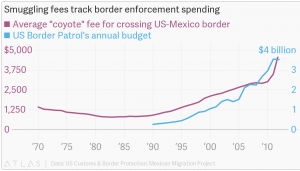Wikipedia defines Coyote as “a colloquial Mexican-Spanish term referring to the practice of people-smuggling across the U.S.-Mexican border”. In border crossing, the coyote assists a migrant in crossing for a fee, which is usually fairly costly, and the costs are continuing to increase (Campoy 2017). The coyote uses their knowledge of the border and security to make money off of the people hoping to cross and come to America.
Ramon, a coyote from Reynosa, Mexico, smuggles people from from the Mexican side of the Rio Grande to the U.S. side. He makes up to 4 trips across the border per week, and has been doing so for almost 6 years. Ramon charges between seven and ten thousand dollars for the whole trip (Bonmati 2016). This money is then partially transferred to the drug cartels, who have control of parts of the border and help the migrants across, as long as they are paid.
Some coyotes are known to scam migrants, promising them a full crossing and leaving them before the trip is over, or often overcharging them for a small part in the journey. Ramon noted that the worst coyotes are the ones who require a full payment upfront. He says these are the ones who are least likely to really take the migrant where they want to go. Instead, the coyotes who are not scam-artists have the migrants travel part by part. For Ramon, the job is to get the migrants across the border, but not necessarily help them mich before and after. Those parts are another coyote’s specialty. Coyotes who promise to take the migrants the full way are usually scams, according to Ramon.
Unlike many coyotes in the business, Ramon actually cares about the people he is helping. He promises them that he will try again if they fail on the first try, and he also says he will try again if they are deported once in the U.S. All he asks is that if they are caught, that his clients do not identify him by name.
Ramon’s contribution to human border smuggling is helping people who need to get to America. He treats his clients as people, preparing them psychologically and physically before the journey, and helping them get to their destination to the greatest extent that he can. This sort of coyote work is beneficial, and can prevent the huge numbers of deaths that occur while migrants are crossing the border. But, the coyotes who scam the migrants for money are only hindering the system, and making it more unsafe to try and cross. If a migrant is able to pay, having someone like Ramon to work with seems like the best and safest option for crossing the border.
Additional Content:
“Inside The Hidden World Of Immigrant Smuggling.” NPR, NPR, 19 Apr. 2012, www.npr.org/2012/04/19/150973748/inside-the-hidden-world-of-immigrant-smuggling.
Noticias, Univision. “Animation: How a Coyote Smuggles Hundreds of Immigrants.” YouTube, YouTube, 19 Dec. 2016, www.youtube.com/watch?v=4-9JVUibkAo.
Sources Cited:
Bonmati, Damia S.
December 21, 2016 A day in the life of a coyote: smuggling migrants from Mexico to the United States. Univision News
Campoy, Ana and Christopher Groskopf
March 17, 2017 The Trump tax: Human smugglers at the US-Mexico border are jacking up prices. Quartz
Images Cited:
https://qz.com/933232/the-trump-tax-human-smugglers-at-the-us-mexico-border-are-jacking-up-prices/
https://www.univision.com/univision-news/immigration/a-day-in-the-life-of-a-coyote-smuggling-migrants-from-mexico-to-the-united-states



Interesting article, but this isn’t really archaeology. So, my extra credit question for you is: How can archaeology help us understand border crossings? What does outside research that you have not learned from class illuminate your understanding about the uses of archaeology in contemporary discourses of migration and border crossing?
The common consensus in contemporary discourses of migration and border crossing is that migrants are “bad”. In order to break this stereotype and create a more effective discourse on the subject, we should turn to archeological patterns of migration. By studying the archeology of patterns of migration, it can be seen that migration is something humans have always done- the concept is not new. Now, with laws and borders and racial profiling, the process of migrating often comes with consequences and prosecution.
Bell beaker culture was one of these migrations. About 4,500 thousand years ago, the Bell Beaker culture was brought my migrants to Britain. This migration suddenly changed the population of Britain at the time. This change has been found through study of DNA of bones found, as well as the movement of the short beaker pottery that the migrants brought from their starting point to their end point. The Bell Beaker, which originated in Iberia, eventually dispersed all throughout western Europe.
Studying the migration of ancient people and cultures such as this one can illuminate the way in which people think about modern migration. Instead of seeing migration from Mexico and South America to the U.S. as a new phenomenon, we should instead treat it as part of the natural human urge to migrate. The migration we are seeing together, although often fueled by unsafe conditions and poverty, is also part of the greater pattern of migration that has been seen in many different cultures, including the Bell Beaker.
Sources:
Howard Hughes Medical Institute. “Ancient DNA tells tales of humans’ migrant history.” ScienceDaily. ScienceDaily, 21 February 2018. .
FORDE, C. D. (1930), EARLY CULTURES OF ATLANTIC EUROPE. American Anthropologist, 32: 19-100. doi:10.1525/aa.1930.32.1.02a00030